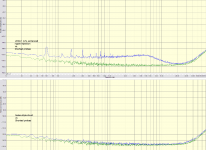Hi everyone, I am thinking of listening to DC power supplies to judge their quality/noise levels.
A few questions:
1. Any tried this (with a DC blocking cap of course)?
2. Is there any merit in this approach?-can it really be used to differentiate between say a bog standard lm317 and a good say SALAS shunt regulator?
3. Links to any other results based on the same approach?
Thanks
Ryan
A few questions:
1. Any tried this (with a DC blocking cap of course)?
2. Is there any merit in this approach?-can it really be used to differentiate between say a bog standard lm317 and a good say SALAS shunt regulator?
3. Links to any other results based on the same approach?
Thanks
Ryan
No.can't you accomplish this with an oscilloscope?
I have an AC or DC input that goes down to 2mV/div and I can't see much useful information on the screen. There is no dominant frequency to lock onto.
As I increase the load on the supply I can see the ripple forming and increasing with the higher output current.
It is easy to lock onto that 100Hz + harmonics and then reduce the loading until the ripple voltage disappears into the narrow band of noise I can just about see as not a "flat line".
If I built a very low noise +20dB/+40dB amplifier, I could probably see much more.
Thanks, so is it best to boost the "noise component" of the power supply and measure that on a scope, rather than try to "listen" to the quality/noise of the power supply?
What about playing music through a simple FET or op-amp based buffer and using various power supplies set at say +-15V (to the buffer) to obtain an idea about PS quality (again say comparing a simple voltage divider with say zener with say LM317 with say shunt based)?
What about playing music through a simple FET or op-amp based buffer and using various power supplies set at say +-15V (to the buffer) to obtain an idea about PS quality (again say comparing a simple voltage divider with say zener with say LM317 with say shunt based)?
I will play music and test signals through the amp, then listen to what ends up on the power supply rails.
Manufacturers note: more effort needed on user manuals.
You can also record the PS using your pc sound card (obviously also with a dc blocking cap) and optionally a preamp and then do an fft analysis of it to see the fundamental and harmonics. Note however you are likely to have problems with 50Hz noise pickup.
I've had mixed results using this method and need to revisit.
Tony.
I've had mixed results using this method and need to revisit.
Tony.
Hi everyone, I am thinking of listening to DC power supplies to judge their quality/noise levels.
A few questions:
1. Any tried this (with a DC blocking cap of course)?
2. Is there any merit in this approach?-can it really be used to differentiate between say a bog standard lm317 and a good say SALAS shunt regulator?
3. Links to any other results based on the same approach?
Thanks
Ryan
This works, but you have to use headphones with high sensitivity, e.g. the 16 ohm ear canal type like Sennheiser Cx series or similar.
Same as Andrew, I cannot see it on the scope.
But I do hear it with the headphones and a +12dB headphone amplifier.
And yes, I can hear an LM317, but not a good shunt circuit.
Best way though is with a sound card and some FFT software like ARTA.
Be careful with the transient through the cap when hooking up to the DC.
Listening to (besides analysing/scoping) the power supply sounds interesting to me!
However you will only hear noise within audio frequency band. What about high frequency isues (EMI, RFI) in the power supply that could be rectified in the audio circuits and influence the performance of the audio circuit?
However you will only hear noise within audio frequency band. What about high frequency isues (EMI, RFI) in the power supply that could be rectified in the audio circuits and influence the performance of the audio circuit?
Best way though is with a sound card and some FFT software like ARTA.
Attachments
Hi Discrete, where is that pic from?
Do you have something similar for:
1. zener with and without CCS
2. ALW
3. Teddyreg
4. etc
Perhaps more to the point. Can you hear the difference that the charts suggest exist?
I took those screenshots from Spectraplus software, using an Emu model 0204 usb DAC.
Unfortunately I do not have other types of regulators measured.
No audible difference (for me anyway) on the audio of the pre-amps they are used in.
But you can hear the noise using a portable headphone amp (4x gain) and the test suggested above.
- Status
- This old topic is closed. If you want to reopen this topic, contact a moderator using the "Report Post" button.
- Home
- Amplifiers
- Power Supplies
- Listening directly to DC Power Supplies
